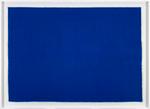Ultramarine
Huang Bo-Hao
黃柏皓
Production date
2014
Object Detail
Media
azurite, lapis lazuli on torinoko paper
Measurements
153 x 213 cm
Notes
Huang Bo-Hao’s works might appear to refer to western Minimalism, or to Zen Buddhist approaches to calligraphy, but the artist says his emphasis is, rather, on the physical interaction of his body with the materials. Working on heavy, absorbent Japanese Torinoko paper, Huang spends months working on a single painting in a process he describes as ‘like weaving.’ For Ultramarine (2014), for instance, he mixed mineral pigments — azurite and lapis lazuli — with water until the solution was as dilute as weak tea. He then used the point of a soft brush to paint small sections, first horizontally from left to right, and then vertically, backwards and forwards, day after day for six months, engaging in a silent, contemplative ‘conversation’ with the paint. Dense and heavy, richly vivid, Ultramarine was built up with fifty separate layers of paint.
These materials are dense with history and symbolism. Lapis from the remote Sar-e-Sang valley in the Badakhshan Mountains of Afghanistan was being carried along the ‘Lapis Lazuli Route’ of the Silk Road to Mesopotamia and Egypt by the second half the fourth millennium BCE, entering China in the first millennium BCE and Europe during the Crusades. By the Middle Ages it was the single most valuable commodity in the world — far more valuable than gold. As well as producing a pigment of the most intense blue, lapis was believed to have magical and healing properties. Azurite, an ore of copper, has also been used since antiquity to produce deep blue pigment. The slight irregularities in the particles of powdered natural pigment create variations across the surface of Ultramarine, so subtle as to be almost invisible.
These materials are dense with history and symbolism. Lapis from the remote Sar-e-Sang valley in the Badakhshan Mountains of Afghanistan was being carried along the ‘Lapis Lazuli Route’ of the Silk Road to Mesopotamia and Egypt by the second half the fourth millennium BCE, entering China in the first millennium BCE and Europe during the Crusades. By the Middle Ages it was the single most valuable commodity in the world — far more valuable than gold. As well as producing a pigment of the most intense blue, lapis was believed to have magical and healing properties. Azurite, an ore of copper, has also been used since antiquity to produce deep blue pigment. The slight irregularities in the particles of powdered natural pigment create variations across the surface of Ultramarine, so subtle as to be almost invisible.
Accession number
2015.008

